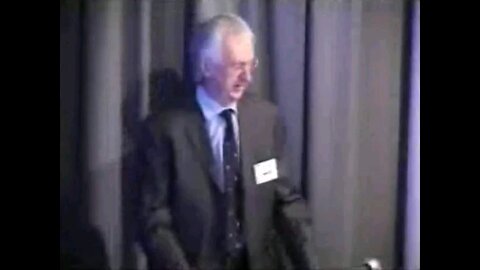
Royal Society of Medicine 2008 on "Chronic Fatigue Syndrome (CFS)"
14 videos
Updated 6 months ago
-
Q: What is Melvin Ramsay's "Myalgic Encephalomyelitis (M.E.) ? | A: Enteroviral Encephalomyelitis - Psychiatrist Peter White (PACE Study Trial Lead Author) (A.I. Remastered Sound)
 Atypical Poliomyelitis (M.E.)Psychiatrist Peter White (Lead author of The PACE Trial Study) https://me-pedia.org/wiki/Peter_White What is Myalgic Encephalomyelitis (M.E.) (aka Enteroviral Encephalomyelitis) ? "It was first described in 1956 by Sir Donald Acheson, in a Lancet Editorial, and he was describing actually a different thing than what I've just been talking about. He was describing epidemics of fatigue with prominent neurological signs and symptoms - something he later regretted doing because he thinks it confused the picture and I think it probably did" "So let's give you a bit of Melvin Ramsey, and this is the Royal Free Epidemic of 1955. This is Ramsay, and 74% showed objective evidence of involvement of the central nervous system, I'm not giving you the whole picture, just a flavour. Heavy involvement of the cranial nerves; objective evidence of brainstem and spinal cord involvement. Paralysis occurred, not just the face but other areas in just under 20%" "In other words, this is a different illness, this is not the same" "Do you see your patients with facial paralysis and do you make a diagnosis of CFS if you have a facial paralysis?" "So I'm suggesting that actually, the original definition of M.E. is different from what I've just been talking about" "How did this happen? I'm afraid we're responsible. There it is. Thirty years ago this very month, I think it was in this building - it didn't ? look like this in those days" "We did it. We transmogrified, we changed, transposed "Epidemic M.E." into "Endemic M.E.". So actually we've got a definition of a different illness that we have transposed onto this illness, which I think is where our problem comes from" "What message - and they also said at that conference - emphatically, this is organic" "What's that word mean? Incurable, Neurological Disease. Okay?" "Now, it may be right. It may be wrong. But what message does this give our patients?" Now, here is the latest edition - you've seen outside - of "M.E. Essential". There are two levels to understand this picture – one: Brave attempts of a woman to cope with a severe, disabling, incurable disease - trying to live a normal life in spite of being ill" "But what message does that give our patients, when we say to them "You have an incurable, Neurological Disease?" "Is it more useful a message for our patients to say that or to say, "Graded Exercise Therapy is a safe and effective treatment, if it's done properly?" "BECAUSE THE TWO STATEMENTS, CANNOT BE AT THIS MOMENT, JOINED TOGETHER" "And here's the evidence. A study again from GPRD of the effect of the doctor saying, "You've got M.E." to patients, compared to saying "You've got Chronic Fatigue Syndrome." What we found was that those labelled "M.E.", their illness lasted longer than those labelled having "Chronic Fatigue Syndrome"; the M.E. patients had more consultations, both in general, and specifically for fatigue with their general practitioner, in spite of the fact that before diagnosis (because this was a longitudinal study) there was no difference between CFS and M.E. in consultation rates or in fatigue consultations suggesting that diagnostic labels we use, have meaning not just for us but for our patients, particularly when they look on the internet for what M.E. and CFS means" "WE NEED TO BE VERY CAUTIOUS in using these labels WITHOUT ADEQUATE EXPLANATION of what THEY REALLY MEAN and how we are going to help our patients" Donald Acheson https://me-pedia.org/wiki/Donald_Acheson A New Clinical Entity? (1956) - The Lancet https://www.thelancet.com/journals/lancet/article/PIIS0140-6736(56)91252-1/fulltext "Benign" Myalgic Encephalomyelitis (1957) - The Lancet https://www.thelancet.com/journals/lancet/article/PIIS0140-6736(57)90999-6/fulltext The clinical syndrome variously called "Benign" Myalgic Encephalomyelitis, Iceland disease and Epidemic Neuromyasthenia - Donald Acheson (1959) https://www.sciencedirect.com/science/article/abs/pii/0002934359902803 "Encephalomyelitis" resembling "Benign" Myalgic Encephalomyelitis - The Lancet (1970) https://www.thelancet.com/journals/lancet/article/PIIS0140-6736(70)91097-4/fulltext Four cases of "Encephalomyelitis" resembling benign "Myalgic Encephalomyelitis" are reported. A Coxsackie B2 virus was isolated from the cerebrospinal fluid in one case and an echovirus type 3 virus from the fæces and the cerebrospinal fluid in another. Serological tests indicated Coxsackie B2 and Coxsackie B5 infection in the other two cases. Mononucleosis-like Syndrome associated with a multisystem Coxsackie virus type B3 infection in adolescence - Springer (1988) https://link.springer.com/article/10.1007/BF00496427 We describe a severe multisystem Coxsackie virus type B3 infection in a previously healthy 14-year-old girl who presented with a mononucleosis-like syndrome (MS). Initial observations included a prominent cervical lymphadenopathy, exudative pharyngitis and leucocytosis with atypical lymphocytosis. At the end of the 2nd week of illness the patient developed meningoencephalomyelitis and haemolytic anaemia. Subclinical myocarditis was also recorded. Prolonged hepatitis recrudescing at the time of recovery coincided with serological evidence of a reactivated Epstein-Barr virus infection. The diagnosis was based on a significant rise in serum antibody titres against Coxsackie virus type B3, using the neutralization test. Intrathecal synthesis of antibodies to Coxsackie virus type B3 was also demonstrated. Generalized Coxsackie virus infections in adolescence are rare and an MS has not, to our knowledge, been associated with Coxsackie virus type B3 infection. Symptoms included: · Cervical Lymphadenopathy · Exudative Pharyngitis · Leucocytosis with Atypical Lymphocytosis · Meningoencephalomyelitis (aka "Epidemic" Myalgic Encephalomyelitis - M.E.) · Hemolytic Anemia · Subclinical Myocarditis · Prolonged Hepatitis recrudescing at the time of recovery Coxsackieviruses are a group of enteroviruses that are common human pathogens and are usually transmitted through the fecal-oral route. They are a leading cause of Aseptic Meningitis and can also cause several syndromes, including a viral prodrome with Fever, Fatigue, Malaise, Myalgia, and Gastrointestinal Upset. Molecular Epidemiology of an Enterovirus A71 outbreak associated with severe "Neurological Disease", Spain, 2016 - Eurosurveillance https://www.eurosurveillance.org/content/10.2807/1560-7917.ES.2019.24.7.1800089 Melvin Ramsay https://me-pedia.org/wiki/Melvin_Ramsay 1955 Royal Free Hospital outbreak https://me-pedia.org/wiki/1955_Royal_Free_Hospital_outbreak Myalgic Encephalomyelitis—a persistent enteroviral infection? (1990) https://academic.oup.com/pmj/article/66/777/526/7061518 Since 1934, "Myalgic Encephalomyelitis (M.E.)" has been increasingly reported from socially developed countries and temperate regions of the world. Endemic prevalence alternates with periodic epidemics, showing a curious predilection for female staff of health care and teaching institutions.' Maximum incidence in both sexes occurs in the third decade. 1934 Los Angeles Atypical Polio Outbreak https://me-pedia.org/wiki/1934_Los_Angeles_atypical_polio_outbreak M.E. is a multisystem syndrome including nervous, cardiovascular, endocrine and other involvement, distinguished by "Severe *Muscle Fatigue* following Trivial Exertion". Other characteristics include high morbidity, low mortality, a prolonged relapsing course and variation in intensity of symptoms within and between episodes, tending to chronicity. Conventional technology is limited in demonstrating abnormalities and this has hitherto permitted *misinterpretation* of the *symptoms as psychogenic*. Historically, a marked similarity to "Non-Paralytic Poliomyelitis" in respect of prodrome, seasonal and geographical incidence caused diagnostic confusion. The return of a local family from holiday with a "Poliomyelitis-like Illness" (of whom 3 subsequently developed M.E.), prompted collaboration between the authors. Differentiation of the M.E. Syndrome from other forms of post-viral debility In our opinion, two major errors are responsible for the present confusion surrounding the case definition, aetiology and diagnosis of M.E.. First, there has been a failure to distinguish the syndrome from post-viral debility following "Epstein-Barr Mononucleosis", influenza and other common fevers. Compared with M.E., these lack the dramatic effect of *exercise* upon "muscle function", the multi-system involvement, diurnal variability of symptoms and prolonged relapsing course. Laboratory tests can distinguish "Chronic Mononucleosis'" and other infections which, as our results show, may occasionally co-exist with M.E. and, by their immunosuppressive effect, precipitate relapse. Second, there has been a failure to recognize the unique epidemiological pattern of M.E., which, from earliest accounts, has lead to confusion with "Non-Paralytic Poliomyelitis." Myalgic Encephalomyelitis (M.E.) or What? An Operational Definition - Frank Twisk (2018) https://www.mdpi.com/2075-4418/8/3/64 Myalgic Encephalomyelitis (M.E.), in the literature also referred to as "Epidemic Neuromyasthenia" and "Non-Paralytic or “Atypical” Poliomyelitis", is a "Neuromuscular Disease" which was identified as a "distinct clinical entity" for the first time in 1956. At that time it was evident that "Muscular Symptoms" (e.g., "Paresis: Muscle Weakness, "Flaccid Paralysis" and "Myalgia") and "Neurological Dysfunction" were the hallmark features of M.E.. M.E. has been classified as a "Neurological Disease" by the World Health Organization (WHO) since 1969. Muscle Fatigability https://me-pedia.org/wiki/Muscle_fatigability#:~:text=Page%20actions&text=Muscle%20fatigability%20in%20ME%20is,full%20muscle%20power%20is%20restored *Muscle fatigability* in M.E. is a symptom in which "Muscles become Weaker" after "minor exertion and a long period (3-5 days or longer) may elapse before full muscle power is restored." According to Melvin Ramsay, it is the defining feature of "Myalgic Encephalomyelitis", without which a diagnosis of M.E. should not be made, though this symptom is noted to improve during remission. Similar muscle effects are known to occur in other "Neurological Diseases" such as "Multiple Sclerosis" and "Post-Polio Syndrome". "Nightingale Research Foundation Definition" by Byron Hyde MD (2016) https://me-pedia.org/wiki/Nightingale_Research_Foundation_definition Post-Infectious Encephalomyelitis: some aetiological mechanisms - Professor Peter Behan (Neurologist) (1978) https://www.ncbi.nlm.nih.gov/pmc/articles/PMC2425308/ The possibility that Acute Disseminated Encephalomyelitis (ADEM) and "Epidemic" Myalgic Encephalomyelitis ('Epidemic Neuromyasthenia') may share a common pathogenesis is examined and many factors common to the two diseases are described. It is suggested that further study of ADEM may help our understanding of "Epidemic" Myalgic Encephalomyelitis (M.E.) Enterovirus RNA - Leeds NHS Teaching Hospital https://www.leedsth.nhs.uk/services/pathology/tests/enterovirus-pcr/ Enteroviruses include; Coxsackieviruses A & B, ECHOviruses, A71, D68, and Polioviruses. These cause a wide range of diseases including; Aseptic Meningitis, rash illness such as Hand, Foot and Mouth Diseases, Pleurisy, Viral Pneumonia, Myocarditis, Pericarditis, Dilated Cardiomyopathy, Tietze Syndrome, Costochondritis, Labyrinthitis (aka Epidemic Vertigo), Limbic Encephalitis, Meningoencephalitis, Rhombencephalitis, Myalgic Encephalomyelitis (M.E.) (aka Enteroviral Encephalomyelitis), Neonatal Sepsis and Bornholm Disease (aka Epidemic Myalgia), Infectious Myositis (Mimicking 'Polymyositis'), Small Fiber "Sensory" Polyneuropathy, Orthostatic Intolerance, Dysautonomias, PoTS, "Peripheral" Facial Palsy, Acute Flaccid Myelitis (AFM), Poliomyelitis-like Syndrome & Guillain-Barré Syndrome (GBS). 01. Viral Throat swab - Pharyngitis Non Vesicular Rash 02. CSF - Meningoencephalitis, Myalgic Encephalomyelitis 03. Pericardial Fluid - Myocarditis, Pericarditis 04. Tissue Biopsy - Internal Organ Infection, Gastrointestinal Biopsy - Stomach or Terminal Ileum, Muscle Biopsy, Meningoencephalitis, Myalgic Encephalomyelitis Enterovirus Protein (VP1) Immunoperoxidase Staining https://www.evmedresearch.com/store/p1/Enterovirus_Protein_%28VP1%29_Immunoperoxidase_Staining.html 05. Faeces - Meningoencephalitis, Myalgic Encephalomyelitis, Myocarditis, Rash 06. Eye Swab - Conjunctivitis 07. Mouth Swab - Mouth Ulcer 08. Skin or Vesicle Swab - Rash EDTA sample – PUO <3 month old Diagnose & Treat - Enterovirus Foundation https://www.enterovirusfoundation.org/treatments-11 comment
Atypical Poliomyelitis (M.E.)Psychiatrist Peter White (Lead author of The PACE Trial Study) https://me-pedia.org/wiki/Peter_White What is Myalgic Encephalomyelitis (M.E.) (aka Enteroviral Encephalomyelitis) ? "It was first described in 1956 by Sir Donald Acheson, in a Lancet Editorial, and he was describing actually a different thing than what I've just been talking about. He was describing epidemics of fatigue with prominent neurological signs and symptoms - something he later regretted doing because he thinks it confused the picture and I think it probably did" "So let's give you a bit of Melvin Ramsey, and this is the Royal Free Epidemic of 1955. This is Ramsay, and 74% showed objective evidence of involvement of the central nervous system, I'm not giving you the whole picture, just a flavour. Heavy involvement of the cranial nerves; objective evidence of brainstem and spinal cord involvement. Paralysis occurred, not just the face but other areas in just under 20%" "In other words, this is a different illness, this is not the same" "Do you see your patients with facial paralysis and do you make a diagnosis of CFS if you have a facial paralysis?" "So I'm suggesting that actually, the original definition of M.E. is different from what I've just been talking about" "How did this happen? I'm afraid we're responsible. There it is. Thirty years ago this very month, I think it was in this building - it didn't ? look like this in those days" "We did it. We transmogrified, we changed, transposed "Epidemic M.E." into "Endemic M.E.". So actually we've got a definition of a different illness that we have transposed onto this illness, which I think is where our problem comes from" "What message - and they also said at that conference - emphatically, this is organic" "What's that word mean? Incurable, Neurological Disease. Okay?" "Now, it may be right. It may be wrong. But what message does this give our patients?" Now, here is the latest edition - you've seen outside - of "M.E. Essential". There are two levels to understand this picture – one: Brave attempts of a woman to cope with a severe, disabling, incurable disease - trying to live a normal life in spite of being ill" "But what message does that give our patients, when we say to them "You have an incurable, Neurological Disease?" "Is it more useful a message for our patients to say that or to say, "Graded Exercise Therapy is a safe and effective treatment, if it's done properly?" "BECAUSE THE TWO STATEMENTS, CANNOT BE AT THIS MOMENT, JOINED TOGETHER" "And here's the evidence. A study again from GPRD of the effect of the doctor saying, "You've got M.E." to patients, compared to saying "You've got Chronic Fatigue Syndrome." What we found was that those labelled "M.E.", their illness lasted longer than those labelled having "Chronic Fatigue Syndrome"; the M.E. patients had more consultations, both in general, and specifically for fatigue with their general practitioner, in spite of the fact that before diagnosis (because this was a longitudinal study) there was no difference between CFS and M.E. in consultation rates or in fatigue consultations suggesting that diagnostic labels we use, have meaning not just for us but for our patients, particularly when they look on the internet for what M.E. and CFS means" "WE NEED TO BE VERY CAUTIOUS in using these labels WITHOUT ADEQUATE EXPLANATION of what THEY REALLY MEAN and how we are going to help our patients" Donald Acheson https://me-pedia.org/wiki/Donald_Acheson A New Clinical Entity? (1956) - The Lancet https://www.thelancet.com/journals/lancet/article/PIIS0140-6736(56)91252-1/fulltext "Benign" Myalgic Encephalomyelitis (1957) - The Lancet https://www.thelancet.com/journals/lancet/article/PIIS0140-6736(57)90999-6/fulltext The clinical syndrome variously called "Benign" Myalgic Encephalomyelitis, Iceland disease and Epidemic Neuromyasthenia - Donald Acheson (1959) https://www.sciencedirect.com/science/article/abs/pii/0002934359902803 "Encephalomyelitis" resembling "Benign" Myalgic Encephalomyelitis - The Lancet (1970) https://www.thelancet.com/journals/lancet/article/PIIS0140-6736(70)91097-4/fulltext Four cases of "Encephalomyelitis" resembling benign "Myalgic Encephalomyelitis" are reported. A Coxsackie B2 virus was isolated from the cerebrospinal fluid in one case and an echovirus type 3 virus from the fæces and the cerebrospinal fluid in another. Serological tests indicated Coxsackie B2 and Coxsackie B5 infection in the other two cases. Mononucleosis-like Syndrome associated with a multisystem Coxsackie virus type B3 infection in adolescence - Springer (1988) https://link.springer.com/article/10.1007/BF00496427 We describe a severe multisystem Coxsackie virus type B3 infection in a previously healthy 14-year-old girl who presented with a mononucleosis-like syndrome (MS). Initial observations included a prominent cervical lymphadenopathy, exudative pharyngitis and leucocytosis with atypical lymphocytosis. At the end of the 2nd week of illness the patient developed meningoencephalomyelitis and haemolytic anaemia. Subclinical myocarditis was also recorded. Prolonged hepatitis recrudescing at the time of recovery coincided with serological evidence of a reactivated Epstein-Barr virus infection. The diagnosis was based on a significant rise in serum antibody titres against Coxsackie virus type B3, using the neutralization test. Intrathecal synthesis of antibodies to Coxsackie virus type B3 was also demonstrated. Generalized Coxsackie virus infections in adolescence are rare and an MS has not, to our knowledge, been associated with Coxsackie virus type B3 infection. Symptoms included: · Cervical Lymphadenopathy · Exudative Pharyngitis · Leucocytosis with Atypical Lymphocytosis · Meningoencephalomyelitis (aka "Epidemic" Myalgic Encephalomyelitis - M.E.) · Hemolytic Anemia · Subclinical Myocarditis · Prolonged Hepatitis recrudescing at the time of recovery Coxsackieviruses are a group of enteroviruses that are common human pathogens and are usually transmitted through the fecal-oral route. They are a leading cause of Aseptic Meningitis and can also cause several syndromes, including a viral prodrome with Fever, Fatigue, Malaise, Myalgia, and Gastrointestinal Upset. Molecular Epidemiology of an Enterovirus A71 outbreak associated with severe "Neurological Disease", Spain, 2016 - Eurosurveillance https://www.eurosurveillance.org/content/10.2807/1560-7917.ES.2019.24.7.1800089 Melvin Ramsay https://me-pedia.org/wiki/Melvin_Ramsay 1955 Royal Free Hospital outbreak https://me-pedia.org/wiki/1955_Royal_Free_Hospital_outbreak Myalgic Encephalomyelitis—a persistent enteroviral infection? (1990) https://academic.oup.com/pmj/article/66/777/526/7061518 Since 1934, "Myalgic Encephalomyelitis (M.E.)" has been increasingly reported from socially developed countries and temperate regions of the world. Endemic prevalence alternates with periodic epidemics, showing a curious predilection for female staff of health care and teaching institutions.' Maximum incidence in both sexes occurs in the third decade. 1934 Los Angeles Atypical Polio Outbreak https://me-pedia.org/wiki/1934_Los_Angeles_atypical_polio_outbreak M.E. is a multisystem syndrome including nervous, cardiovascular, endocrine and other involvement, distinguished by "Severe *Muscle Fatigue* following Trivial Exertion". Other characteristics include high morbidity, low mortality, a prolonged relapsing course and variation in intensity of symptoms within and between episodes, tending to chronicity. Conventional technology is limited in demonstrating abnormalities and this has hitherto permitted *misinterpretation* of the *symptoms as psychogenic*. Historically, a marked similarity to "Non-Paralytic Poliomyelitis" in respect of prodrome, seasonal and geographical incidence caused diagnostic confusion. The return of a local family from holiday with a "Poliomyelitis-like Illness" (of whom 3 subsequently developed M.E.), prompted collaboration between the authors. Differentiation of the M.E. Syndrome from other forms of post-viral debility In our opinion, two major errors are responsible for the present confusion surrounding the case definition, aetiology and diagnosis of M.E.. First, there has been a failure to distinguish the syndrome from post-viral debility following "Epstein-Barr Mononucleosis", influenza and other common fevers. Compared with M.E., these lack the dramatic effect of *exercise* upon "muscle function", the multi-system involvement, diurnal variability of symptoms and prolonged relapsing course. Laboratory tests can distinguish "Chronic Mononucleosis'" and other infections which, as our results show, may occasionally co-exist with M.E. and, by their immunosuppressive effect, precipitate relapse. Second, there has been a failure to recognize the unique epidemiological pattern of M.E., which, from earliest accounts, has lead to confusion with "Non-Paralytic Poliomyelitis." Myalgic Encephalomyelitis (M.E.) or What? An Operational Definition - Frank Twisk (2018) https://www.mdpi.com/2075-4418/8/3/64 Myalgic Encephalomyelitis (M.E.), in the literature also referred to as "Epidemic Neuromyasthenia" and "Non-Paralytic or “Atypical” Poliomyelitis", is a "Neuromuscular Disease" which was identified as a "distinct clinical entity" for the first time in 1956. At that time it was evident that "Muscular Symptoms" (e.g., "Paresis: Muscle Weakness, "Flaccid Paralysis" and "Myalgia") and "Neurological Dysfunction" were the hallmark features of M.E.. M.E. has been classified as a "Neurological Disease" by the World Health Organization (WHO) since 1969. Muscle Fatigability https://me-pedia.org/wiki/Muscle_fatigability#:~:text=Page%20actions&text=Muscle%20fatigability%20in%20ME%20is,full%20muscle%20power%20is%20restored *Muscle fatigability* in M.E. is a symptom in which "Muscles become Weaker" after "minor exertion and a long period (3-5 days or longer) may elapse before full muscle power is restored." According to Melvin Ramsay, it is the defining feature of "Myalgic Encephalomyelitis", without which a diagnosis of M.E. should not be made, though this symptom is noted to improve during remission. Similar muscle effects are known to occur in other "Neurological Diseases" such as "Multiple Sclerosis" and "Post-Polio Syndrome". "Nightingale Research Foundation Definition" by Byron Hyde MD (2016) https://me-pedia.org/wiki/Nightingale_Research_Foundation_definition Post-Infectious Encephalomyelitis: some aetiological mechanisms - Professor Peter Behan (Neurologist) (1978) https://www.ncbi.nlm.nih.gov/pmc/articles/PMC2425308/ The possibility that Acute Disseminated Encephalomyelitis (ADEM) and "Epidemic" Myalgic Encephalomyelitis ('Epidemic Neuromyasthenia') may share a common pathogenesis is examined and many factors common to the two diseases are described. It is suggested that further study of ADEM may help our understanding of "Epidemic" Myalgic Encephalomyelitis (M.E.) Enterovirus RNA - Leeds NHS Teaching Hospital https://www.leedsth.nhs.uk/services/pathology/tests/enterovirus-pcr/ Enteroviruses include; Coxsackieviruses A & B, ECHOviruses, A71, D68, and Polioviruses. These cause a wide range of diseases including; Aseptic Meningitis, rash illness such as Hand, Foot and Mouth Diseases, Pleurisy, Viral Pneumonia, Myocarditis, Pericarditis, Dilated Cardiomyopathy, Tietze Syndrome, Costochondritis, Labyrinthitis (aka Epidemic Vertigo), Limbic Encephalitis, Meningoencephalitis, Rhombencephalitis, Myalgic Encephalomyelitis (M.E.) (aka Enteroviral Encephalomyelitis), Neonatal Sepsis and Bornholm Disease (aka Epidemic Myalgia), Infectious Myositis (Mimicking 'Polymyositis'), Small Fiber "Sensory" Polyneuropathy, Orthostatic Intolerance, Dysautonomias, PoTS, "Peripheral" Facial Palsy, Acute Flaccid Myelitis (AFM), Poliomyelitis-like Syndrome & Guillain-Barré Syndrome (GBS). 01. Viral Throat swab - Pharyngitis Non Vesicular Rash 02. CSF - Meningoencephalitis, Myalgic Encephalomyelitis 03. Pericardial Fluid - Myocarditis, Pericarditis 04. Tissue Biopsy - Internal Organ Infection, Gastrointestinal Biopsy - Stomach or Terminal Ileum, Muscle Biopsy, Meningoencephalitis, Myalgic Encephalomyelitis Enterovirus Protein (VP1) Immunoperoxidase Staining https://www.evmedresearch.com/store/p1/Enterovirus_Protein_%28VP1%29_Immunoperoxidase_Staining.html 05. Faeces - Meningoencephalitis, Myalgic Encephalomyelitis, Myocarditis, Rash 06. Eye Swab - Conjunctivitis 07. Mouth Swab - Mouth Ulcer 08. Skin or Vesicle Swab - Rash EDTA sample – PUO <3 month old Diagnose & Treat - Enterovirus Foundation https://www.enterovirusfoundation.org/treatments-11 comment -
Simon Wessely says he can understand the emotion involved with criticism of The Wessely School's bogus research and charlatan psychiatric/psychology researchers but finds it hard to sympathize with Myalgic Encephalomyelitis (M.E.) sufferers.
 Atypical Poliomyelitis (M.E.)"It's not possible really though to avoid the outside world much as though we would like and this kind of demonstration, squeeze the sites out of M.E. and one can understand the emotions but I do find it hard to sympathize and I also think it's a great mistake" - Simon Wessely Wessely School https://me-pedia.org/wiki/Wessely_school Biopsychosocial Model https://me-pedia.org/wiki/Biopsychosocial_model
Atypical Poliomyelitis (M.E.)"It's not possible really though to avoid the outside world much as though we would like and this kind of demonstration, squeeze the sites out of M.E. and one can understand the emotions but I do find it hard to sympathize and I also think it's a great mistake" - Simon Wessely Wessely School https://me-pedia.org/wiki/Wessely_school Biopsychosocial Model https://me-pedia.org/wiki/Biopsychosocial_model








